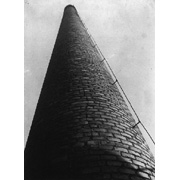| ALBERT RENGER-PATZSCH German, 1897-1966 |
||
|
At the outset of his career in the early 1920s,
Renger-Patzsch was fascinated by the duality of nature and the machine. The same
years in America found the concepts mdchine and nature expressed like a mantra
in the work of some of the very best photographers, most notably Paul
Strand and Edward Weston (related to-->>187,188).
Paul Strand became obsessed with the highly precise forms
of his Ackeley motion-picture camera and the lathes used to manu- facture it,
while also being fascinated by plants and rocks. In 1922, Weston, on his way from
Los Angeles to New York, stopped for a few days in Middletown, Ohio, where he
studied the interaction of meandering ventilation pipes and the adjacent geometric
architectural forms. In Germany, Renger-Patzsch was totally in tune with the spirit
of such experimental attitudes, which by 1927 Ied him to formulate a credo to
express his position: "The secret of a good photograph . . . resides in its realism
. . . [its] rigid linear structure-only photography is capable of that-. . . the
mechanical reproduction of form-is what makes [photogra- phy] superior to all
other means of expression." |
